The Design and Analysis of Internally Stiffened GFRP Tubular Decks—A Sustainable Solution
Abstract
:1. Introduction
2. Materials and Geometries of Tubular Decks
2.1. FRP Composite Material
2.2. Geometries of Tubular Decks
3. Theory and Validation
3.1. Finite-Element Model of the GFRP Tube
3.2. Experimental Validation of the Finite-Element Model
4. Finite-Element Analysis of Internally Stiffened GFRP Tubular Decks
5. Numerical Analysis Results and Discussion
5.1. Numerical Analysis of the Bending Stiffness
5.2. Numerical Analysis of the Torsional Stiffness
6. Conclusions
- (1)
- For the 7.5 × 7.5 cm square tube profile with thickness 0.5 cm subjected to the three-point bending test, the finite-element numerical results were in good agreement with the experimental results. The deflection values of various tubular decks calculated from the TBT are much closer to the experimental data than that of the EBT. Therefore, the shear deformation needs to be considered.
- (2)
- For the bending analysis, the tubular decks with stiffener patterns of the “O” type, “V” type, and “D” type show superior performance compared to others. Their bending stiffness compared to the non-stiffened benchmark tubular deck increased by 44.39%, 33.29%, and 33.26%, respectively.
- (3)
- For the torsional analysis, the tubular decks with stiffener patterns that form circular patterns or closed shapes inside each profile performed better than their counterparts. The tubular decks with stiffener patterns of the “O” type, and “D” type show superior performance compared to others. Their torsional stiffness compared to the non-stiffened benchmark tubular deck increased by 80.08%, 71.29%, and 33.26%, respectively.
- (4)
- The “O” type tubular deck clearly showed excellent performance under the bending and torsional loadings. Compared to the non-stiffened benchmark tubular deck, the “O” type tubular deck showed an increase of 44.39% and 80.08% in bending and torsional stiffness, respectively.
- (5)
- Based on the finite-element numerical analysis results, it is possible to distinguish which internally stiffened sections have better bending or torsional rigidity. However, before extensively using the internally stiffened sections in engineering applications, these finite-element models should be carefully checked.
Author Contributions
Funding
Conflicts of Interest
References
- Li, Y.F.; Yu, C.C.; Chen, S.Y.; Badjie, S. The carbon footprint calculation of the GFRP pedestrian bridge at Tai-Jiang National Park. Int. Rev. Spat. Plan. Sustain. Dev. 2013, 1, 13–28. [Google Scholar] [CrossRef]
- Zhang, C.; Amaduddin, M.; Canning, L. Carbon dioxide evaluation in a typical bridge deck replacement project. Proc. Inst. Civ. Eng. 2011, 164, 183–194. [Google Scholar] [CrossRef]
- Knippers, J.; Pelke, E.; Gabler, M.; Berger, D. Bridges with glass fiber-reinforced polymer decks: The road bridge in Friedberg, Germany. Struct. Eng. Int. 2010, 20, 400–404. [Google Scholar] [CrossRef]
- Areiza-Hurtado, M.; Bansal, A.; Paulotto, C.; Primi, S. FRP girder bridges: Lessons learned in Spain in the last decade. In Proceedings of the 6th International Conference on FRP Composites in Civil Engineering, Rome, Italy, 13–15 June 2012. [Google Scholar]
- Li, Y.F.; Badjie, S.; Chen, W.W.; Chiu, Y.T. Case study of first all-GFRP pedestrian bridge in Taiwan. Case Stud. Constr. Mater. 2014, 1, 83–95. [Google Scholar] [CrossRef]
- Li, Y.F.; Badjie, S.; Chiu, Y.T.; Chen, W. Placing an FRP bridge in Taijiang national park and in virtual reality. Case Stud. Constr. Mater. 2018, 8, 226–237. [Google Scholar] [CrossRef]
- Bakis, C.E.; Bank, L.C.; Brown, V.L.; Cosenza, E.; Davalos, J.F.; Lesko, J.J.; Machida, A.; Rizkalla, S.H.; Triantafillou, T.C. Fiber-reinforced polymer composites for construction—State-of-the-art review. J. Compos. Constr. 2002, 6, 73–87. [Google Scholar] [CrossRef]
- Valbona, M.; Reza, H.; Peter, H. Bridge decks of fibre reinforced polymer (FRP): A sustainable solution. J. Constr. Build. Mater. 2014, 50, 190–199. [Google Scholar]
- Valbona, M.; Al-Emrani, M.; Kliger, R. Upgrading of an existing concrete–steel bridge using fibre reinforced polymer deck—A feasibility study. In Proceedings of the FRP Bridges Conference, London, UK, 13–14 September 2012. [Google Scholar]
- Federal Highway Administration. Composite Bridge Decking: Final Project Report, Publication No. FHWA-HIF-13-029; Federal Highway Administration: Washington, DC, USA, 2013.
- Majumdar, P.K. Strength and Life Prediction of FRP Composite Bridge Deck. Ph.D. Thesis, Virginia Polytechnic Institute and State University, Blackburg, VA, USA, 2008. [Google Scholar]
- Wu, Z.H.; Mirmiran, A.; Zhu, Z.Y.; Swanson, J. Flexural behavior of prestressed FRP tubular bridge deck. Compos. Part B 2009, 40, 125–133. [Google Scholar] [CrossRef]
- Volz, J.S.; Chandrashekhara, K.; Birman, V.; Hawkins, S.; Hopkins, M.; Huo, Z.; Mohamed, M.; Tuwair, H. Polyurethane Foam Infill for Fiber-Reinforced Polymer (FRP) Bridge Deck Panels; Missouri Department of Transportation: Jefferson, MO, USA, 2014.
- Zi, G.; Kim, B.M.; Hwang, Y.K.; Lee, Y.H. The static behavior of a modular foam-filled GFRP bridge deck with a strong web-flange joint. Compos. Struct. 2008, 85, 155–163. [Google Scholar] [CrossRef]
- Zi, G.; Kim, B.M.; Hwang, Y.K.; Lee, Y.H. An experimental study on static behavior of a GFRP bridge deck filled with a polyurethane foam. Compos. Struct. 2008, 82, 257–268. [Google Scholar] [CrossRef]
- Mostafa, A.; Shankar, K.; Morozov, E.V. Experimental, theoretical and numerical investigation of the flexural behaviour of the composite sandwich panels with PVC foam core. Appl. Compos. Mater. 2014, 21, 661–675. [Google Scholar] [CrossRef]
- Alagusundaramoorthy, P.; Harik, I.E.; Choo, C.C. Structural behavior of FRP composite bridge deck panels. J. Bridge Eng. 2006, 11, 384–393. [Google Scholar] [CrossRef]
- Hong, T.H.; Hastak, M. Construction, inspection, and maintenance of FRP deck panels. J. Compos. Constr. 2006, 10, 561–572. [Google Scholar] [CrossRef]
- Brown, D.L.; Berman, J.W. Fatigue and strength evaluation of two glass fiber-reinforced polymer bridge decks. J. Bridge Eng. 2010, 15, 290–301. [Google Scholar] [CrossRef]
- Srivastava, I.; Dey, T.; Chakrabarti, A.; Bhargava, P. Structural optimization of FRP web core decks. J. Compos. Constr. 2013, 17, 395–405. [Google Scholar] [CrossRef]
- Li, Z. Testing and Analysis of a Fiber-Reinforced Polymer (FRP) Bridge Deck. Ph.D. Thesis, Virginia Polytechnic Institute and State University, Blackburg, VA, USA, 2008. [Google Scholar]
- ASTM International. ASTM D790: Standard Test Methods for Flexural Properties of Unreinforced and Reinforced Plastics and Electrical Insulating Materials; ASTM International: West Conshohocken, PA, USA, 2017. [Google Scholar]
- Cowper, G.R. The Shear Coefficient in Timoshenko’s Beam Theory. J. Appl. Mech. 1996, 33, 335–340. [Google Scholar] [CrossRef]
- Valbona, M. Fibre Reinforced Polymer Bridge Decks—A Feasibility Study on Upgrading Existing Concrete-Steel Bridges. Master’s Thesis, Chalmers University of Technology, Göteborg, Sweden, 2011. [Google Scholar]



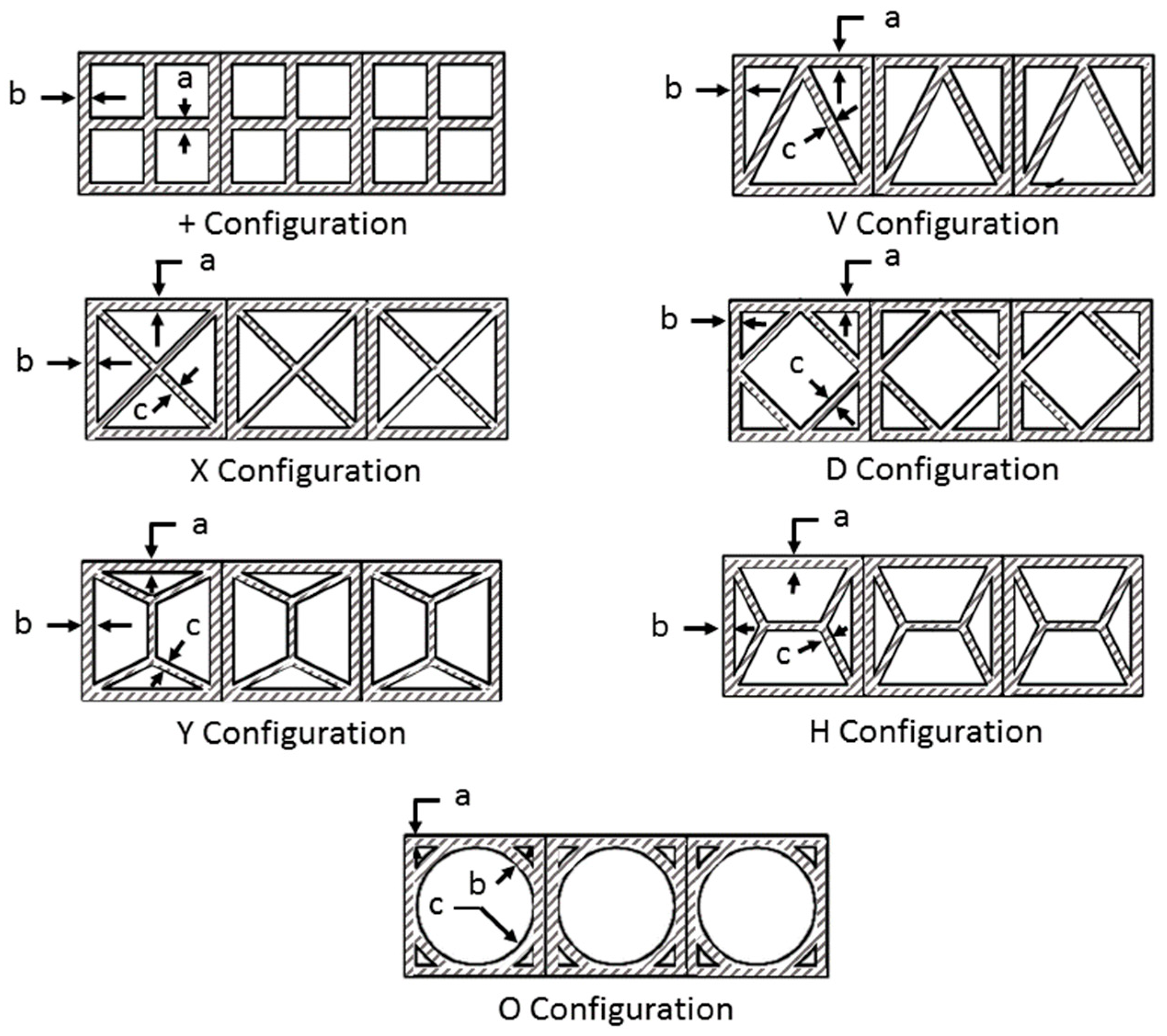
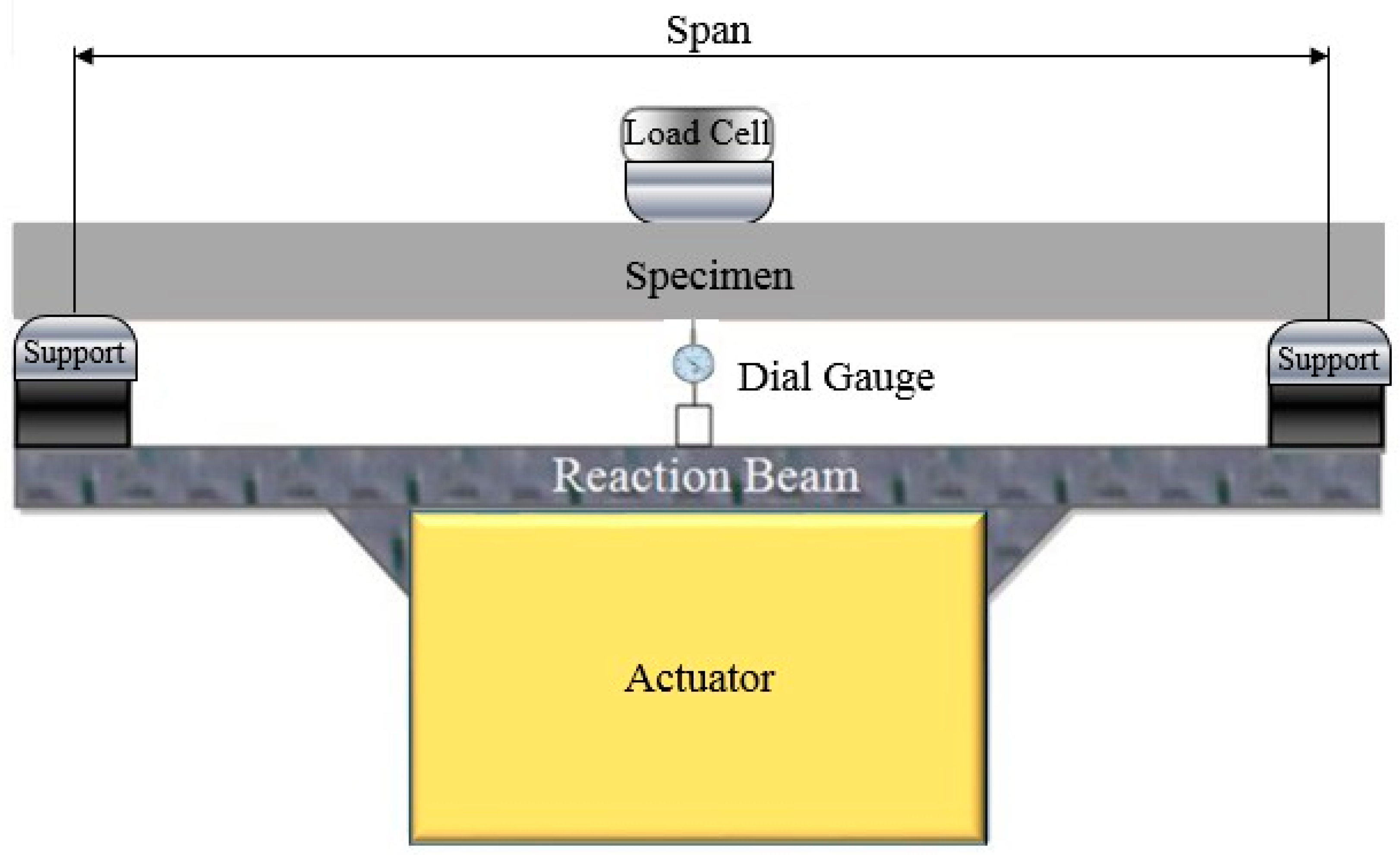

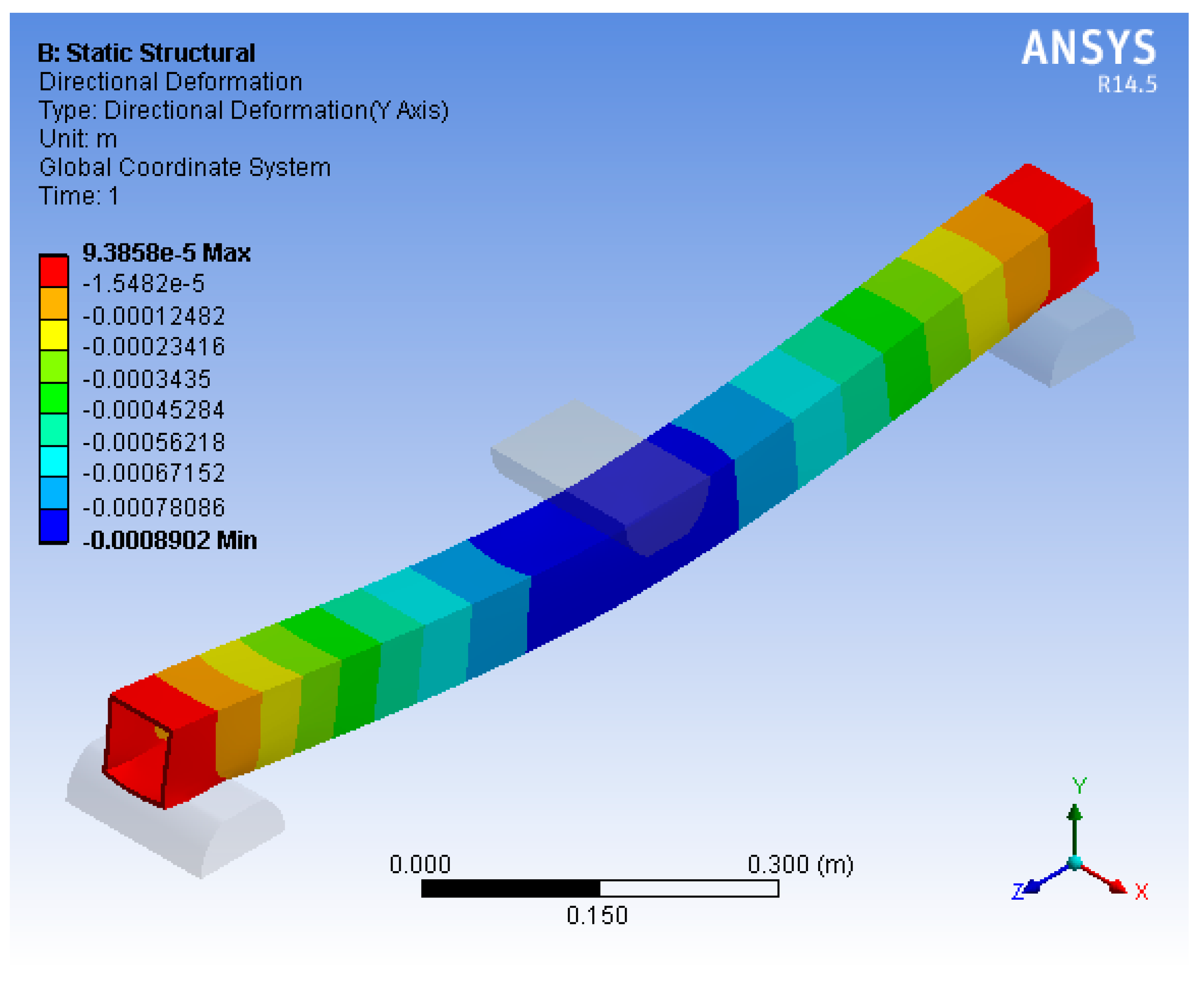

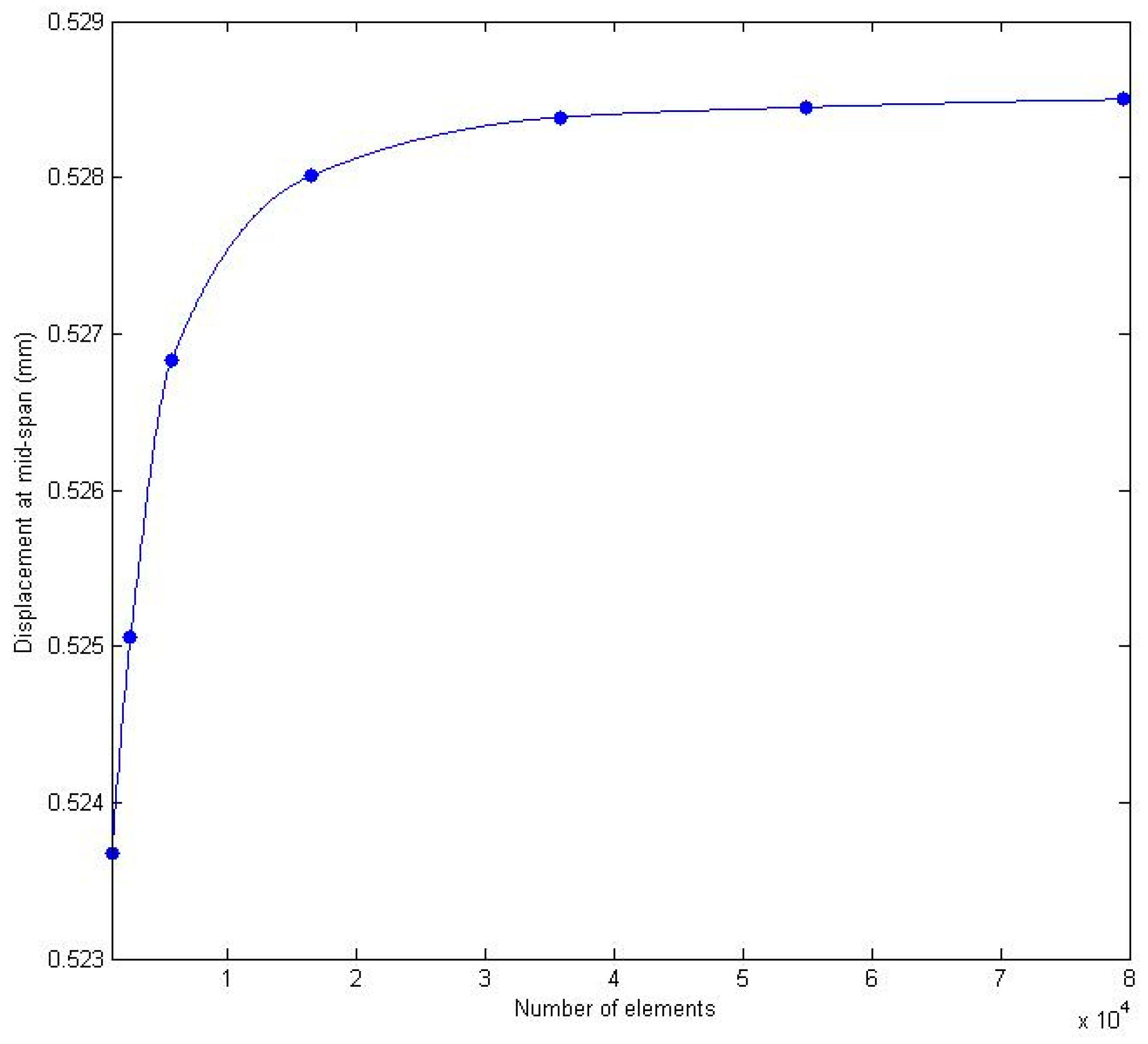
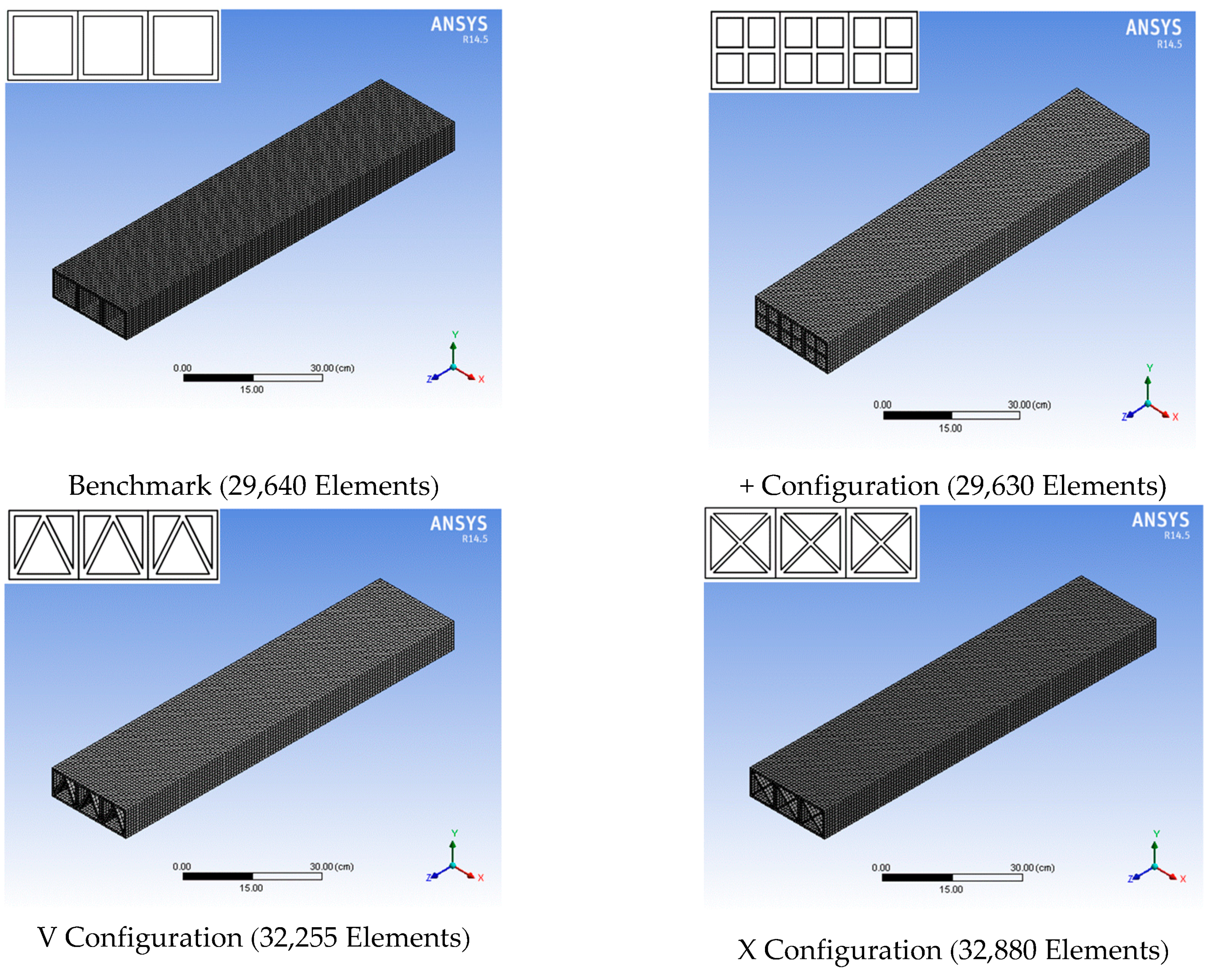
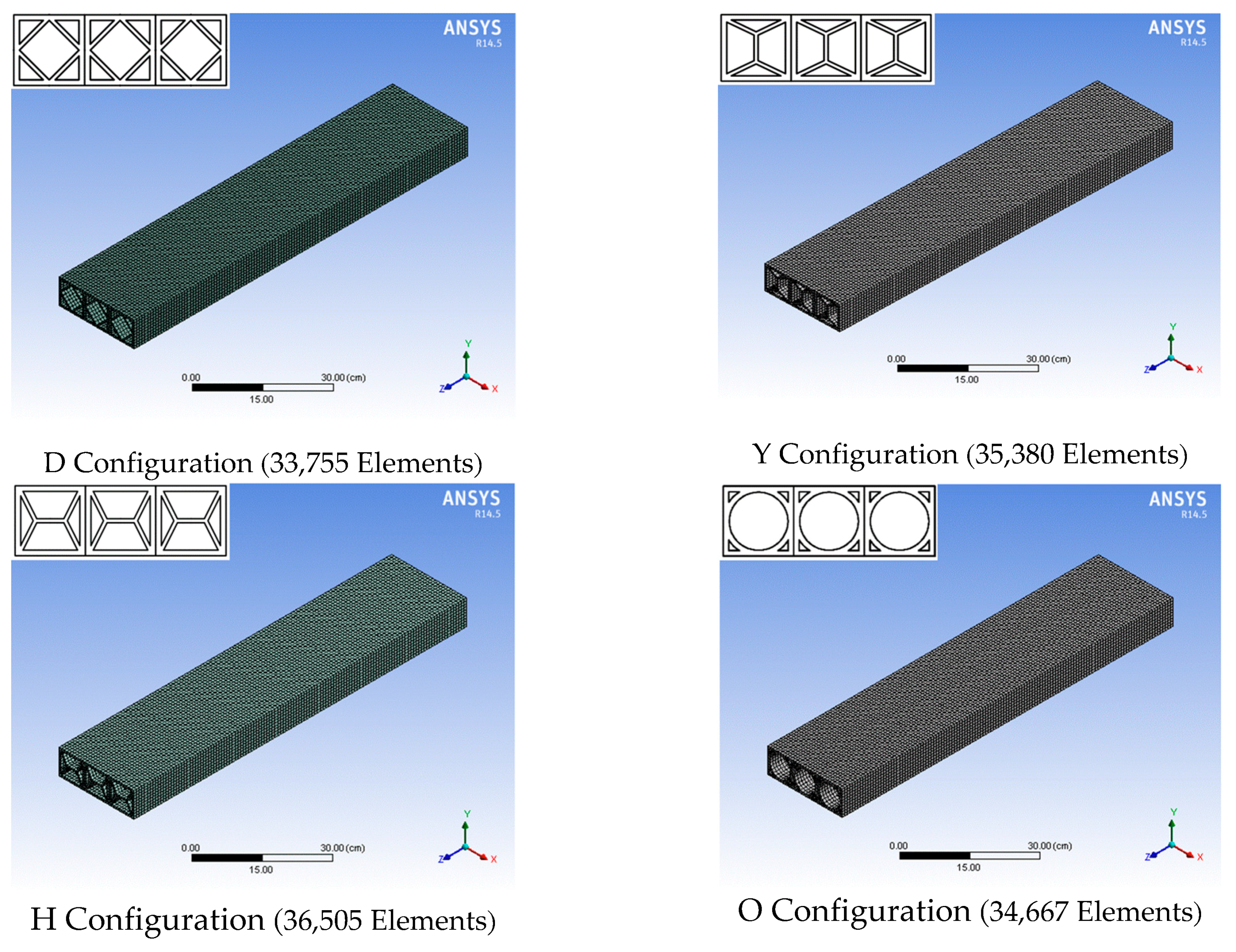
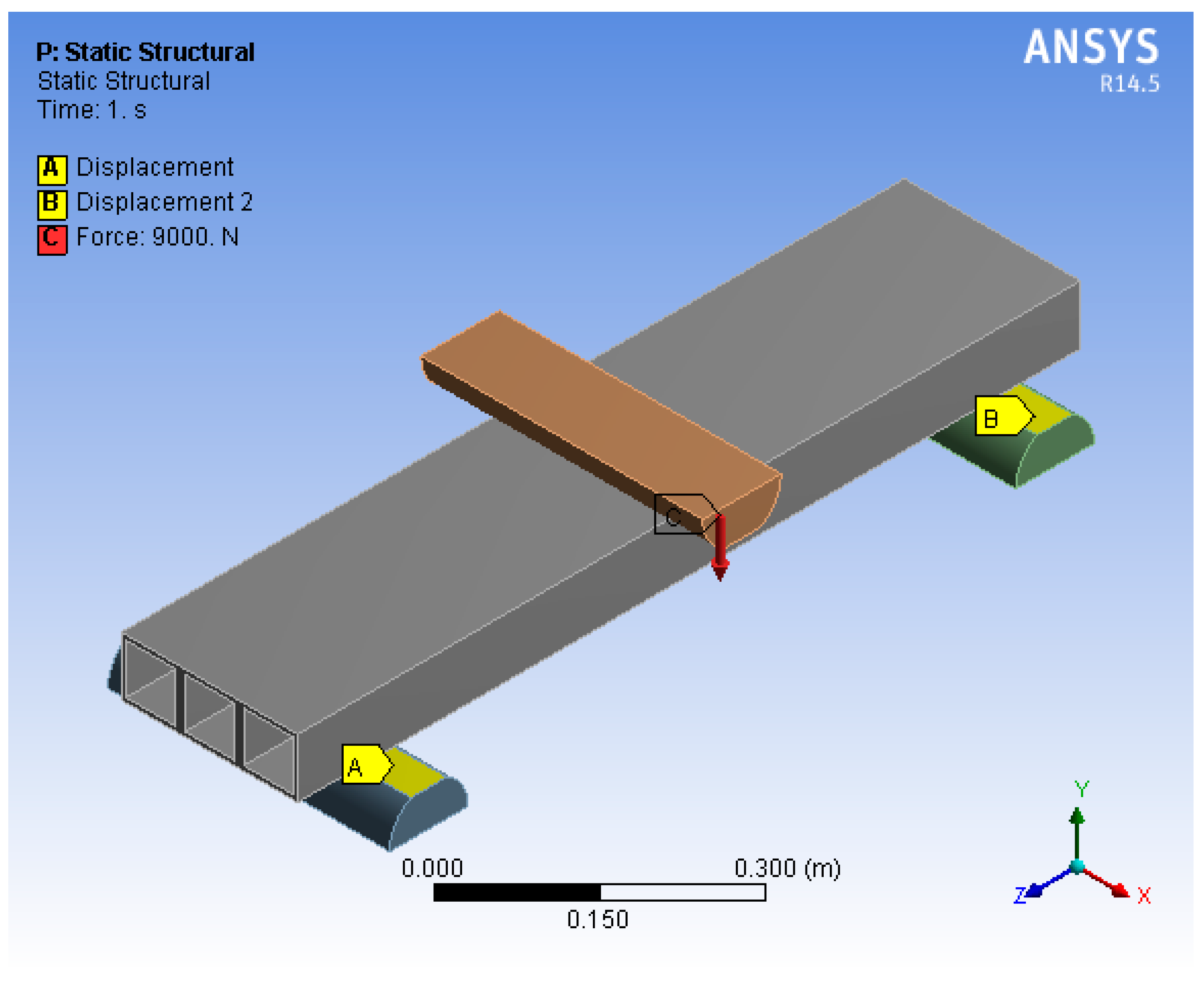

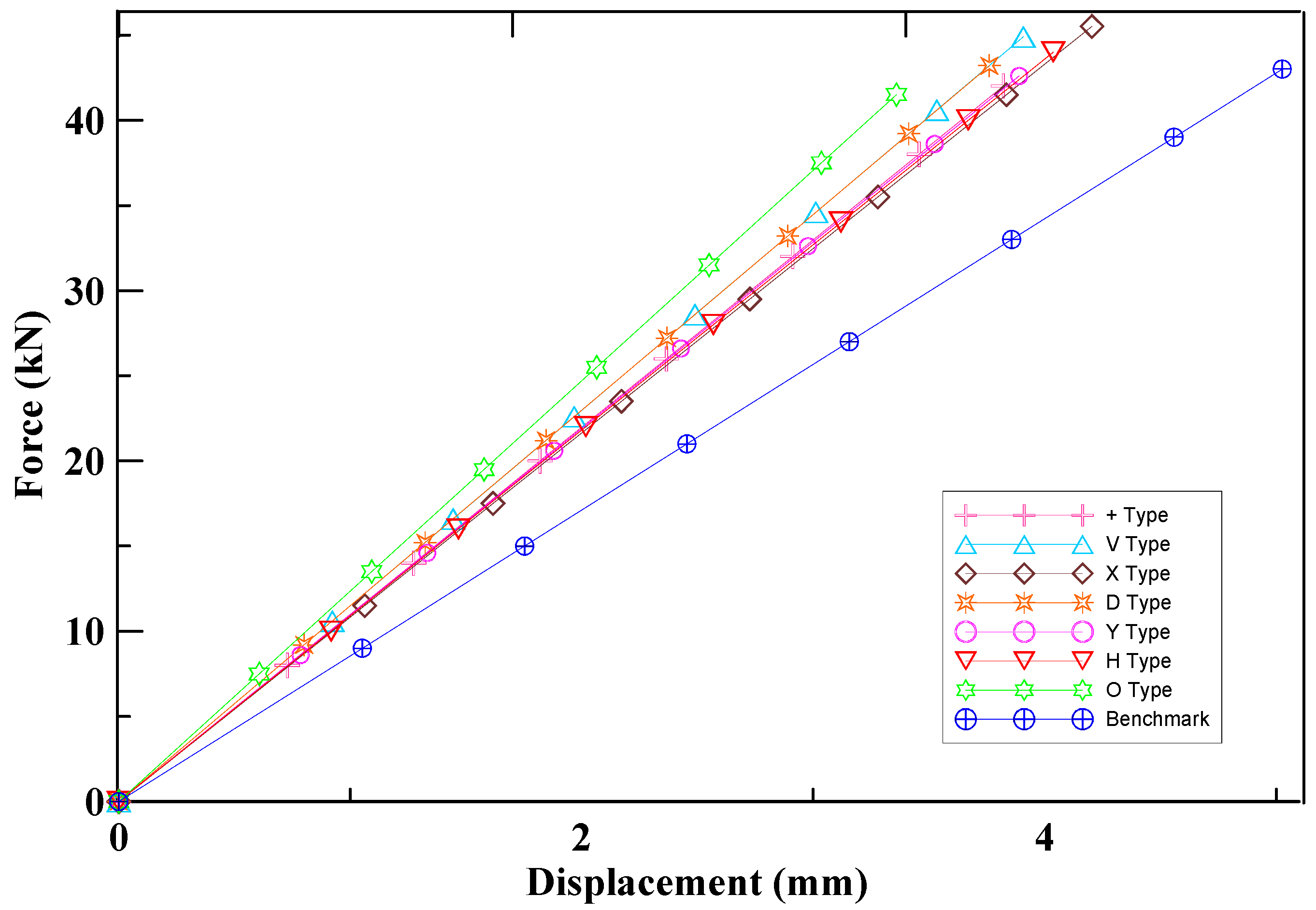
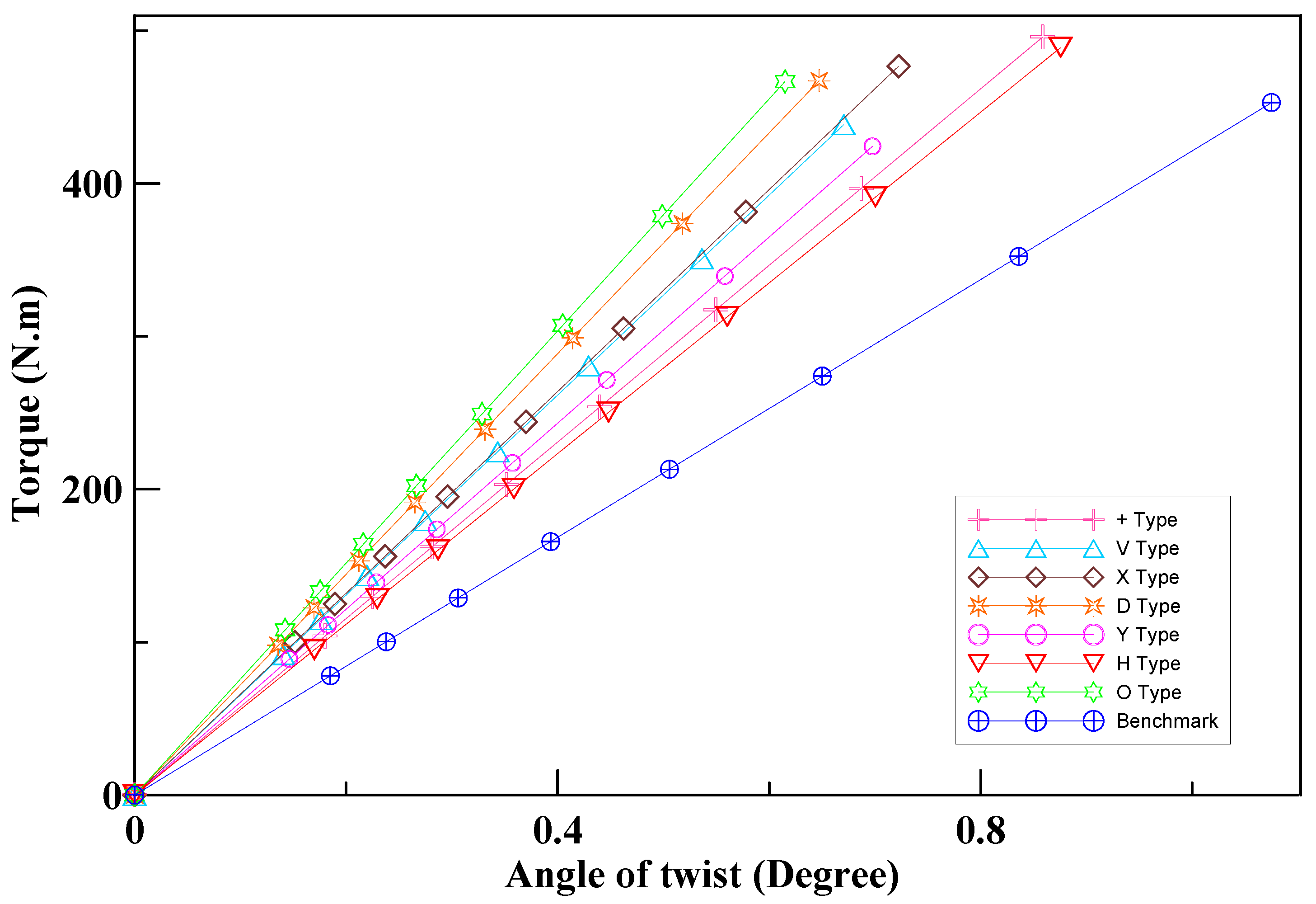
| Property | Directionality | |
|---|---|---|
| Lengthwise ᵃ | Crosswise ᵇ | |
| Density | 1800 kg/m3 | |
| Tensile ultimate strength (MPa) | 210 | |
| Compressive ultimate strength (MPa) | 210 | |
| Young’s modulus (MPa) | 21,000 | 2625 |
| Poisson’s ratio | 0.038 | 0.33 |
| Shear modulus (MPa) | 3150 | 3150 |
| Details | Stiffener Configuration | |||||||
|---|---|---|---|---|---|---|---|---|
| + | V | X | D | Y | H | O | ||
| Dimension (cm) | a * | 0.6 | 0.6 | 0.6 | 0.6 | 0.6 | 0.6 | 0.6 |
| b * | 0.6 | 0.6 | 0.6 | 0.6 | 0.6 | 0.6 | 0.64 | |
| c * | - | 0.54 | 0.42 | 0.45 | 0.44 | 0.44 | 3.11 | |
| Relative cross sectional area | 1 | 1.0018 | 0.9971 | 1.0004 | 0.9989 | 0.9989 | 0.9987 | |
| Methods | Maximum Deflection δmax (mm) | Percentage Error (%) |
|---|---|---|
| Experiment | 5.211 | - |
| Finite-element Analysis | 5.352 | 2.70 |
| Euler Beam Theory | 4.396 | 15.63 |
| Timoshenko Beam Theory | 5.354 | 2.74 |
| Deck Stiffener Pattern | Moment of Inertia Ix (cm4) | Bending Stiffness (kN/cm) | Bending Stiffness Increase (%) |
|---|---|---|---|
| Benchmark | 413.75 | 85.55 | - |
| X | 490.4 | 108.23 | 26.51 |
| H | 618.41 | 108.99 | 27.40 |
| + | 458.78 | 109.90 | 28.46 |
| Y | 525.66 | 109.51 | 28.00 |
| V | 487.54 | 114.89 | 34.29 |
| D | 500.51 | 114.86 | 34.26 |
| O | 543.53 | 123.53 | 44.39 |
| Deck Stiffener Pattern | Polar Moment of Inertia, J (cm4) | Torsional Stiffness (N-m/degree) | Torsional Stiffness Increase (%) |
|---|---|---|---|
| Benchmark | 2789.86 | 421.45 | - |
| H | 4666.87 | 558.55 | 32.53 |
| + | 3590.61 | 577.58 | 37.04 |
| Y | 3671.92 | 608.30 | 44.33 |
| V | 3656.73 | 654.30 | 55.24 |
| X | 3646.21 | 660.06 | 56.61 |
| D | 3676.03 | 721.90 | 71.29 |
| O | 3756.67 | 758.98 | 80.08 |
© 2018 by the authors. Licensee MDPI, Basel, Switzerland. This article is an open access article distributed under the terms and conditions of the Creative Commons Attribution (CC BY) license (http://creativecommons.org/licenses/by/4.0/).
Share and Cite
Li, Y.-F.; Meda, H.A.; Chen, W. The Design and Analysis of Internally Stiffened GFRP Tubular Decks—A Sustainable Solution. Sustainability 2018, 10, 4538. https://doi.org/10.3390/su10124538
Li Y-F, Meda HA, Chen W. The Design and Analysis of Internally Stiffened GFRP Tubular Decks—A Sustainable Solution. Sustainability. 2018; 10(12):4538. https://doi.org/10.3390/su10124538
Chicago/Turabian StyleLi, Yeou-Fong, Habib Armel Meda, and Walter Chen. 2018. "The Design and Analysis of Internally Stiffened GFRP Tubular Decks—A Sustainable Solution" Sustainability 10, no. 12: 4538. https://doi.org/10.3390/su10124538







